Memorial & Bereavement Quilts - How to Plan
Updated: July 15th, 2024 | Published: November 14th, 2022
18 min. read
By Andrea Funk
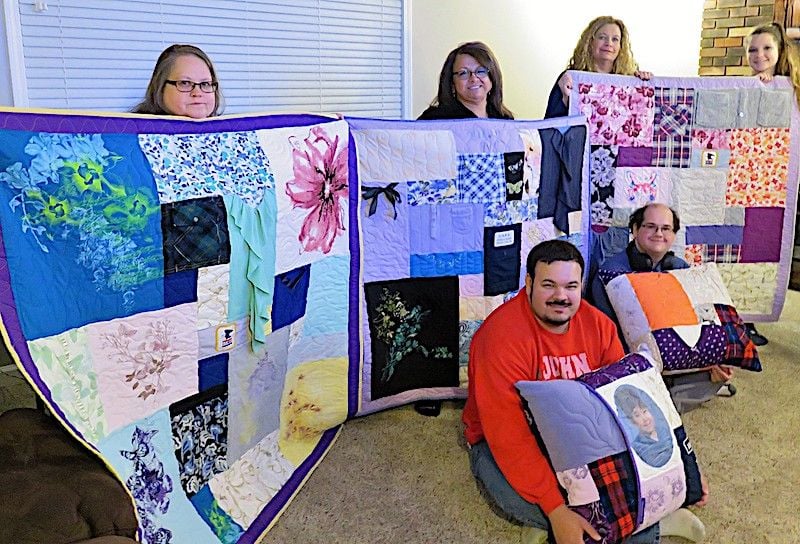
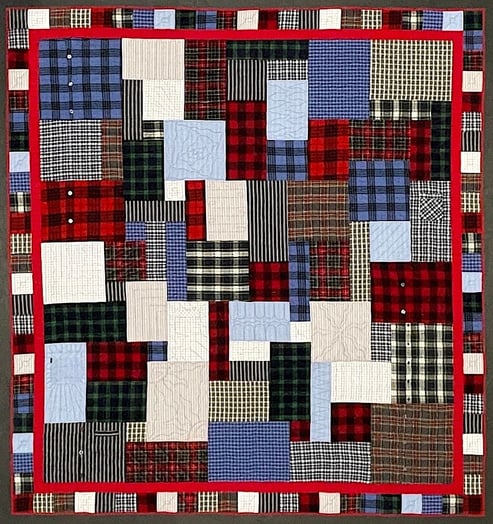 Introduction
Introduction
When I lost my husband Larry, it was his clothing that kept bringing me down. His clothes smelled like him. One sniff and then all the memories would come flooding back. I would find myself with my nose buried in his shirts sobbing.
Eventually your loved one’s clothing will lose that smell, but the clothes still aren’t just clothes. They are a very powerful reminder of your loved one. "This shirt was the one they wore on the day you went to the fair or this sweater you bought for them on a family vacation."
Donating their clothing to a Goodwill or a resale store might not be something you are able to stomach. If you are looking to do something with your deceased loved one’s clothing, consider having a quilt or a pillow made. These quilts are sad and you should expect a good cry when you your quilt back. But over time, a quilt will become a comfort.
This article will go over a number of topics that will help you plan and have your memorial quilt made. You can read from top to bottom or click on the topic you are interested in.
Table of Contents
When to Have a Memorial Quilt Made
Who Should Receive a Memorial Quilt?
What Can You Use in a Memorial Quilt?
Tips on Sorting Your Deceased Loved One’s Clothing for a Quilt
How Much Does a Memorial Quilt Cost?
Conclusion
When to Have a Memorial Quilt Made
We know grief is different for everyone. Some people work through the grief of losing a loved one in a matter of months. While other people never do. Grief is universal, but very personal.
The section focuses on the timing of making a memorial quilts. Below I will share our experience of making quilts too soon after the death of a loved one. I will go into the issues of making a quilt too soon and why you should wait.
Is it Way Too Soon?
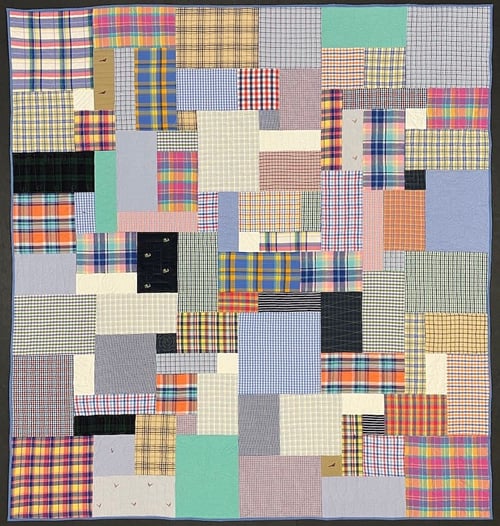 Recently we made 3 quilts for a woman we will call Karen. While Karen was dropping off her husband’s clothing, we learned she had lost her husband just two weeks before. Two weeks!
Recently we made 3 quilts for a woman we will call Karen. While Karen was dropping off her husband’s clothing, we learned she had lost her husband just two weeks before. Two weeks!
We knew as soon as she left that we were in trouble. It was way too soon for us to have accepted her clothing. And we were right.
Now if you’re thinking, it’s none of our business how soon after someone dies their family send us their T-shirts or clothing. And you would be right.
That is, until it is our business. When we are blamed for decisions they made and when they refuse to pay, it then becomes our business.
Issues with Making a Quilt Too Soon
There are a number of issues with having a T-shirt/memory quilt made so soon after someone dies.
1. Your Brain Is Not Working Well Enough to Make Decisions
When someone you love dies, part of your brain dies too. When my husband Larry died, my head buzzed for the first month. I was there, but not there. Slowly, over a number of weeks and months, my brain settled down and I was able to start thinking again.
Making important decision in this time period should be avoided.
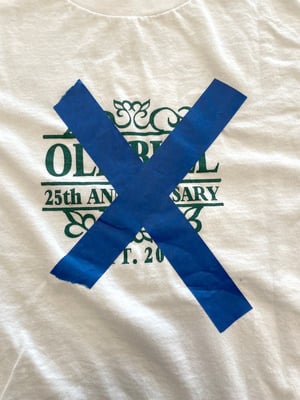 When Karen came in, she had to make a number of decisions. Here are some of those decisions and how they effected the outcome of her quilts.
When Karen came in, she had to make a number of decisions. Here are some of those decisions and how they effected the outcome of her quilts.
- When Karen arrived, she had not separated the clothing and T-shirts into three groupings – one for each of the quilts we were going to make. She had also not decided what to include and exclude from each individual T-shirt.
The result? A block she did not want was included in a quilt. This particular graphic had not been marked to be excluded. She is very angry at us for having included this block.
Unless you mark what you don’t want on your T-shirts, we use everything. We can’t read your mind. This is why it’s very important you look at all your T-shirts including the back, front and arms. Read about how to mark your T-shirts here. 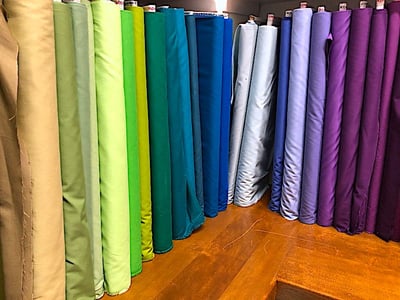 When Karen was here she said she wanted blue for the binding. And that is the color we used. When Karen came to pick up the quilts, she claimed that she had told us to use black. She hates blue.
When Karen was here she said she wanted blue for the binding. And that is the color we used. When Karen came to pick up the quilts, she claimed that she had told us to use black. She hates blue.
We showed her the order form and our emails to her showing her that she had indeed asked us to use blue. Again, she is angry about this.
Before you decide to have a quilt made, make sure you are okay with the decisions you need to make. If your brain is not functioning, step back and wait.
2. All the Clothing Items Might Not Have Been Found
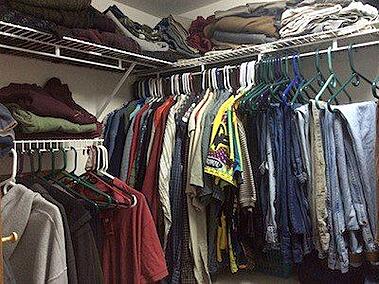 When you go to collect all the clothing from a person who died it will take time to find everything. It’s amazing how spread out we are in our homes.
When you go to collect all the clothing from a person who died it will take time to find everything. It’s amazing how spread out we are in our homes.
Two weeks after Karen dropped off her clothing, she came across two more T-shirts she wanted to include in her quilt. We told her that it was too late. We were too far into the quilt too include additional items. Again, she was angry with us. Give yourself time to go through everything and find all the clothing you want to include.
3. Your Financial Situation Might Not Be Completely Understood
 When someone you love dies, there are a lot of financial items to figured out. What monthly income will you have? What expenses have to get paid now? For example, medical bills or funeral expenses. You might not have a clear picture about how much disposable income you will have available for sometime.
When someone you love dies, there are a lot of financial items to figured out. What monthly income will you have? What expenses have to get paid now? For example, medical bills or funeral expenses. You might not have a clear picture about how much disposable income you will have available for sometime.
Don’t commit to having a number of quilts made until you know if you can afford them. This happens more often than you might think!
We believe that this was Karen’s main issue. Ultimately, we think she just didn't have the money to pay for the quilts. I am sure when she began the process, she thought she would have the resources to pay.
We went above and beyond for Karen. We wanted her to be comfortable with us and know that her T-shirts were in the good hands. We wrote everything down and kept copies of every conversation we had. In the end, nothing we did, or could do, made her happy. It was just too soon for her to handle the emotional and financial stress of such a large project.
Waiting - Your Best Option
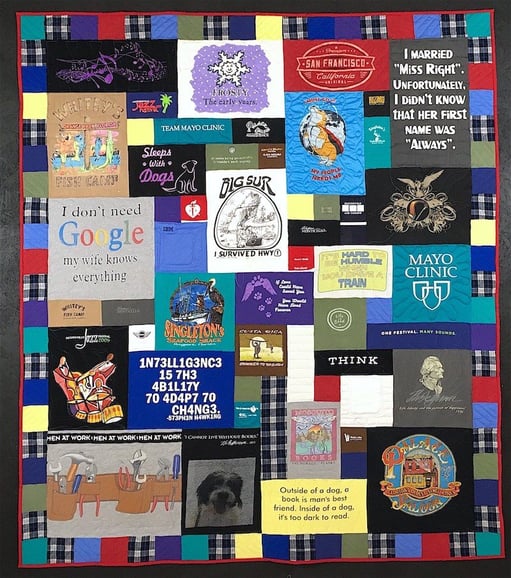 We want you to have a good experience having a quilt made. We know that it will be difficult no matter how long ago your loved one died.
We want you to have a good experience having a quilt made. We know that it will be difficult no matter how long ago your loved one died.
Based on over 30 years of experience, here are our suggestion on having a memory quilt made.
1. Wait for 3 Months or More
We would suggest you wait a minimum of three months before you begin the process of having a quilt made. We know from experience that any sooner is a recipe for heartache.
2. Know Your Financial Situation
Don’t begin a memorial quilt project until you know you can afford to have the quilt(s) made. It may take many months to figuring out your new reality.
3. Spend Time Preparing the Clothing
- Be sure you have all the clothing items collected. Double check the coat closet, the back of the car, in the camper, in the gym locker. All those weird places you might not have thought about right away.
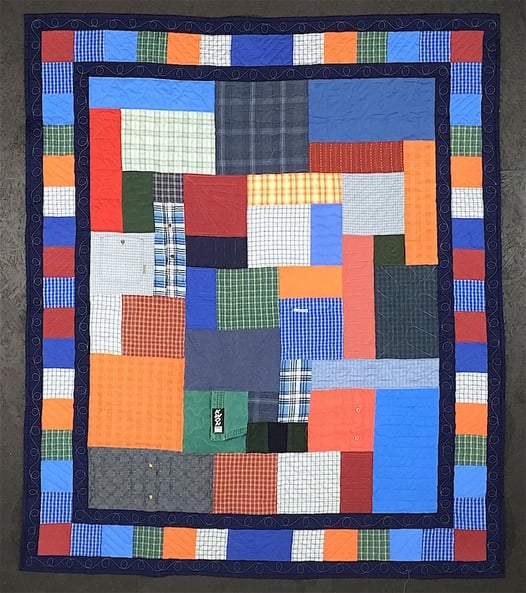 Take the time to wash all the items.
Take the time to wash all the items. - Until you are ready to have your quilt made, place all the clothing items in one spot. They can be out of sight, but ready to go when you are.
- Go through each item at least once to make sure you want to include it in your quilt.
- Go through the items and the process with a friend or child. This will be like having a backup brain. Our friends feel helpless when we loses a loved one. Having them help with your quilt is a great way to let them help you.
Section Summary
If you are wondering if it is too soon to have a memorial quilt made, it probably is. Take your time! We will be here when you are ready.
↑Back to the Table of Contents
Planning a memorial quilt or pillow?
Here are step-by-step directions for ordering your Too Cool quilt or pillow.
Who Should Receive a Memorial Quilt?
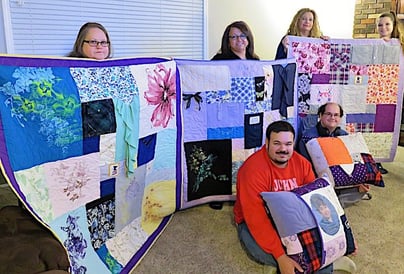 Most of the time, we make more than one memorial quilt from a deceased loved one’s clothing. For example, when a parent has died and left behind school age children, we typically make one for each child and for the surviving parent.
Most of the time, we make more than one memorial quilt from a deceased loved one’s clothing. For example, when a parent has died and left behind school age children, we typically make one for each child and for the surviving parent.
When I lost my husband Larry, I ended up making 10 quilts for his friends and family. It was only after I shipped all the quilts out that I realized that I had not made one for myself. To this day I kick myself for not having made one for myself.
If you have lost your spouse, I think it is very important to have one made for yourself. Even if you are not ready now, put some of the clothing items aside for later.
1. Decide Who May Like/Want a Quilt or Pillow
Begin by deciding who might like a quilt or a pillow. This will be contingent on your budget and how many clothing items you have. We have found that a typical adult wardrobe can make about 5 to 8 queen-size quilts or many smaller quilts and pillows.
2. Decide Who Will Receive a Quilt and Who Receives a Pillow
 Next, figure out if you need quilts, pillows or a mix of quilts and pillows. This will depend on how many people you have on your list and your budget.
Next, figure out if you need quilts, pillows or a mix of quilts and pillows. This will depend on how many people you have on your list and your budget.
Here are a few examples:
- A young parent has died and left two children and a spouse. This would be a great time to have a quilt made for each. If the parents of the deceased are involved, they might like to have a pillow.
Possible Solution: three quilts and two pillows. - A grandparent has died and has 8 grandchildren and a spouse. The spouse may like a quilt. A pillow for the grandchildren would be a wonderful way for them to remember their grandparent.
Possible Solution: one quilt and 8 pillows.  A child has died and has left behind parents, grandparents, siblings and friends. Depending on the age and wardrobe of the child, there might not be enough clothing to make something for everyone. We would suggest first making something for the siblings and then the parents. If there is enough to make additional pillows or small quilts, then the grandparents might be next in line.
A child has died and has left behind parents, grandparents, siblings and friends. Depending on the age and wardrobe of the child, there might not be enough clothing to make something for everyone. We would suggest first making something for the siblings and then the parents. If there is enough to make additional pillows or small quilts, then the grandparents might be next in line.
Possible Solution: a small quilt for each sibling, and a larger quilt for the parents. Or a large quilt for the parents and a pillow for each sibling.- A baby has died. The baby clothing, blankets and bibs could be made into a quilt for the parents. Although these are the saddest quilts for us to make, we know the impact of the quilt is enormous. Read more about baby clothes quilts here.
Possible Solution: a quilt for the parents of the child.
↑Back to the Table of Contents
What Can You Use in a Memorial Quilt?
Generally, we can mix and match any clothing items. With that said, some items work better than others. Below are a list of items to consider using and one of items to think about leaving out.
If you send us something that cannot be used, we will let you know and return it with your quilt.
Items to Consider Putting in a Memorial Quilt
 T-shirts, Sweatshirts, Jerseys, Tank Tops
T-shirts, Sweatshirts, Jerseys, Tank Tops- Dress Shirts, Work Shirts, Polo Shirts
- Blankets, Quilts
- Sweatpants, running shorts
- Blue Jeans
- Slacks
- Logos from Baseball Caps
- Bathrobes
- Coats, Gloves, Hats
- Neckties
- Photographs transferred onto fabric. Read more here.
Things to Consider Leaving Out of a Memorial Quilt
- Underwear & Bras
- Socks and hosiery
- Anything with a bad memory associated with it
- Jewelry
- Shoes – with perhaps the exception of soft-soled baby shoes
- Things that are not soft and that would not be fun to curl up with
- Something that, if it were you who died, you would not want in a quilt.
You Can Mix and Match Any Fabrics in a Memorial Quilt
 The one important thing to remember is that when you mix and match fabrics, you must follow the cleaning directions of the most delicate fabric. So, if all the items in your quilt are machine wash, tumble dry, that is how you would care for the quilt.
The one important thing to remember is that when you mix and match fabrics, you must follow the cleaning directions of the most delicate fabric. So, if all the items in your quilt are machine wash, tumble dry, that is how you would care for the quilt.
But, if one item were machine wash, line dry, then you would have to care for the quilt in that manner.
This is most important when you mix dry-clean only items with regular wash and dry clothing. If there is one clothing item that is dry-clean only, then your quilt needs to be dry-cleaned.
You will remember to dry-clean your quilt. But, will someone in two or three generations remember to dry-clean the quilt? The memorial quilt you have made should last generations. Think ahead to the long-term use of this memorial quilt.
↑Back to the Table of Contents
Tips on Sorting Your Deceased Loved One’s Clothing for a Quilt
Here is a plan you can follow to make sorting through your loved one's clothing a little easier. Unfortunately, this knowledge has come from firsthand experience. Hang in there, you can do this!
Clean and Put Away
First, make sure that all the clothing is clean and put away as it would have been if your loved one were sitting in the next room. This way you only have to go through this process once and you won’t be surprised when something turns up in a week or a month.
Tools to Assist in the Sorting Process
- A roll of plastic trash bag
- Boxes or clothes baskets labeled with the name of the quilts or pillows you planning on having made.
- Pen and paper for notes.
- A roll of blue painters masking tape to mark any parts of the items you don’t want use. More information about marking your T-shirts and other items is here.
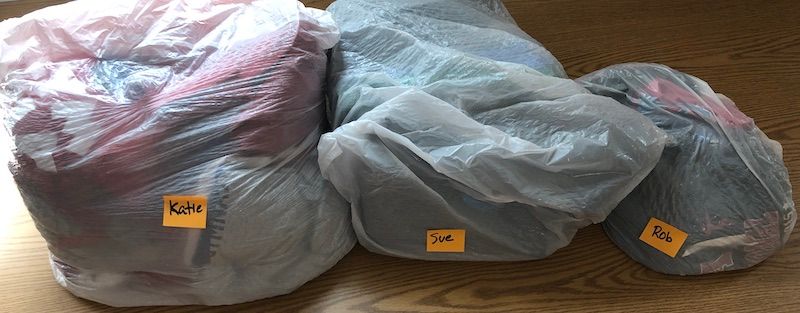
The Actual Sorting
Set aside a block of time for the project. There may be times during this process that you will become sad and need to take a break. This is a difficult task, and it might be helpful to have someone else help out and to tell stories to. Or you might want to do this by yourself so you can take all the time you want to contemplate and remember.
Consider breaking the sorting process down into smaller components so the job is not as overwhelming. For example, pull 10" of hangers off the bar and no more.
The Closet
 Pull out any item that you hated or had never seen your loved wear. Those are clearly the easy ones to set aside for donation or resale.
Pull out any item that you hated or had never seen your loved wear. Those are clearly the easy ones to set aside for donation or resale.- Go through the items one at a time and sort them into your piles. Have a pile labeled for each quilt or pillow you plan on having made. Also have a pile for donation and trash.
As you remove each item from its hanger, consider which quilt or pillow it should go into. Remember that if an item is “dry-clean only”, the quilt you put it into will also be “dry-clean only.” - Items you may find in a closet:
-
- Bathrobes –usable
- Neckties – usable. But are dry-clean only. We can make a quilt from just neckties.
- Suspenders – usable
- Shoes and slipper – not usable. (They wouldn’t be much fun to snuggle up with!)
Dresser Drawer
 Open one drawer at a time. This will make the task less overwhelming.
Open one drawer at a time. This will make the task less overwhelming. - Pull out anything that you hate and don’t ever want to see again. Those are for donation or the trash.
- Go through the items one at a time and sort into their respective boxes or baskets.
- Special items you might find in a dresser:
-
- Socks – we can use them several different ways.
- Bras & Underwear – consider if you really want to use them. We can use them if you want.
- Scarfs and handkerchiefs – we can use these.
Coat Closet
- Start with the hanging items. We can use pieces from coats and jackets. Keep in mind the care of the jacket.
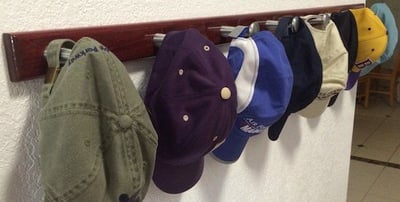 Special items you might find in the closet:
Special items you might find in the closet:
-
- Baseball cap – we can use the logo from the cap.
- Gloves – can be used. The way they are cleaned is a consideration to think about.
- Stocking hats & winter hats – can be used.
- Boots and shoes – not usable.
Odds and Ends
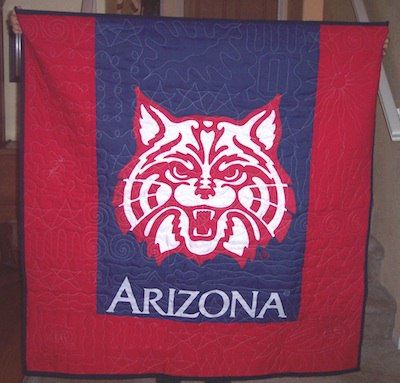 You might find other items of the deceased that you would like included in your quilt. Here are some items we can use in whole or use a piece of:
You might find other items of the deceased that you would like included in your quilt. Here are some items we can use in whole or use a piece of:
- Flags and banners
- Stuffed animals
- Doilies
- Towels – Kitchen, bath, swimming, golf, etc.
- Table clothes
- Blankets
- Athletic gear that is cloth. For example, running shorts, bicycle jerseys and shorts, and swimming suits.
Click here to read about other items that can be a quilt.
Section Summary
A memorial quilt made from your loved one’s clothing tells their story. We can mix and match just about any cloth item into your quilt. You are more than welcome to send us anything you would like in the quilt. If we are unable to use it, we will let you know and return it with your quilt.
↑Back to the Table of Contents
How to Plan Multiple Memorial Quilts from One Person's Clothing
Planning a quilt or pillow for more than one person from your loved one's clothing will take some planning and sorting.
1. Figure Out How Many Items You Have to Work With
This will help you determine how many quilts you can have made based on how many clothing items you have.
How Many Items Do You Need for a Quilt?
 I knew you were going to ask that question. I don't have a set answer such as 17 or 35. How many items you need depends on how many items you have and how you want to use those items.
I knew you were going to ask that question. I don't have a set answer such as 17 or 35. How many items you need depends on how many items you have and how you want to use those items.
- Larger quilts need more and can accommodate more items.
- Smaller quilts need fewer items and can be made with fewer items.
Clothing can offer more options than T-shirts because we can cut multiple pieces from each clothing item. For example, small quilts can be made from made from 6 to 9 clothing items.
- The fewer items you have, the more and the larger blocks we will cut from each item.
- The more items you have, the less we will cut from each piece. And if you have a lot of items, we will cut smaller pieces from each item.
For large lap size quilts, I would suggest no fewer than 6 item and no more 25 items. But the system is flexible.
To Complicate Planning...
You can use a piece out of one shirt for many quilts. Depending on the size pieced used, you can use the same shirt in 5 to 8 quilts. The smaller we cut the blocks, the more quilts you can include that item in. We can take one shirt and cut it so there is nothing left but the old seams. Or we can just take one block out of a shirt.
Memorial Pillows
We would suggest between 4 and 8 items per pillow. So much easier!

2. Set-up a Box or Bag for Each Quilt or Pillow
Starts with your list of everyone who needs a quilt or pillow. Write each name on a slip of paper or tape. Then attach the name onto a box or bag. You will put each clothing item that goes in that quilt in their box or bag.
You will have a pile/box/bag labeled for each quilt or pillow. Then make a pile for donation. As you remove each item from its hanger or drawer, consider what quilt or pillow it should go into. Remember that if an item is dry-clean only, the quilt you put it into will also be dry-clean only.
3. Choosing Who Gets Which Clothing Items
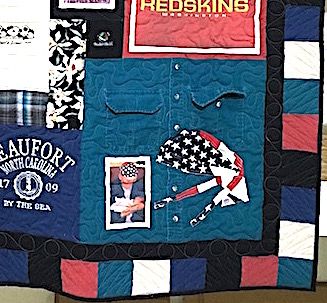 Don't let this become a family freak show. Most items can be shared between more than one quilt. Most people have an outfit that they remember that person wearing most. Start there. Put each person's favorite item in their bag.
Don't let this become a family freak show. Most items can be shared between more than one quilt. Most people have an outfit that they remember that person wearing most. Start there. Put each person's favorite item in their bag.
Then think about photos you have of that person. What were they wearing and who were they with? This is another way to divide up the clothing. This works great with two person photos.
Are you making a quilt for a young person or child? If so, don't put a dry-clean only item in their quilt. If you put a dry-clean only item in a quilt, the entire quilt becomes dry-clean only. If they can't wash their quilt, they won't use it. And these quilts should be used and enjoyed.
4. Analyze Each Grouping
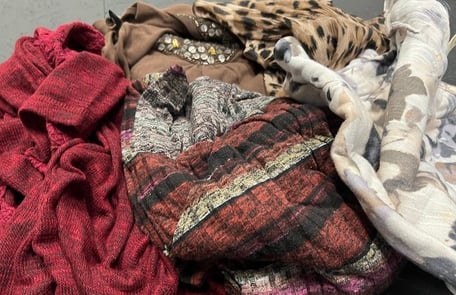 After you get everything sorted out, open up one bag or box at a time. You want to look at all the colors in the stack of clothing. Do they all go well together? Step back and squint at the pile or stack of items. Is there one or two items that just look awful? Pull those out for now.
After you get everything sorted out, open up one bag or box at a time. You want to look at all the colors in the stack of clothing. Do they all go well together? Step back and squint at the pile or stack of items. Is there one or two items that just look awful? Pull those out for now.
As you check your other groupings, look to see if the ones you pulled out from another grouping work with that grouping.
Keep shuffling your groupings to find the right mix of colors and textures.
5. How to Use One Item in More Than One Quilt
 The simple way is to divide up the clothing items into one stack for each quilt you would like made. But, we all know that life is not simple. There are some items may need to go into each quilt. Other items may need to go into two quilts, but not, say, all four.
The simple way is to divide up the clothing items into one stack for each quilt you would like made. But, we all know that life is not simple. There are some items may need to go into each quilt. Other items may need to go into two quilts, but not, say, all four.
Start by setting out another bag for the clothing items that need to go into more than one quilt. Stick a piece of blue painters tape on each clothing item listing the name or quilt number that should have a block from that item.
If there is a T-shirt in this pile with a front and a back, tape the name or quilt number of the quilt that each particular side goes in.
How Too Cool T-shirt Quilts Works With Your Items
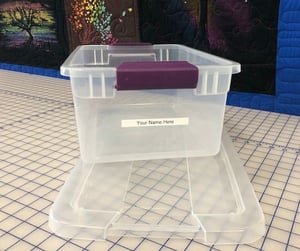 We will set up a plastic storage box for each grouping or bag of items. Then, working one grouping at a time, we will cut the items from that bag. Once all the individual groupings are cut, we line up the labeled plastic storage boxes and then work from the bag containing items that needs a piece to go into more than one quilt. As we cut that clothing item, we put a piece in each specified quilt box.
We will set up a plastic storage box for each grouping or bag of items. Then, working one grouping at a time, we will cut the items from that bag. Once all the individual groupings are cut, we line up the labeled plastic storage boxes and then work from the bag containing items that needs a piece to go into more than one quilt. As we cut that clothing item, we put a piece in each specified quilt box.
Section Summary
Take your time planning your memorial quilts. They are too important to rush. If this seems too hard to think about right now, it's too soon. Put it off another 6 months or year. Just put the clothing aside for when you feel more up to it.
↑Back to the Table of Contents
How Much Does a Memorial Quilt Cost?
 Typically a memorial quilt will cost the about the same as a regular T-shirt quilt. Click here to connect to our pricing page. The cost of a memorial quilt may be a little more if there are items that need additional work done with them.
Typically a memorial quilt will cost the about the same as a regular T-shirt quilt. Click here to connect to our pricing page. The cost of a memorial quilt may be a little more if there are items that need additional work done with them.
There are 3 major cost Involved with making a memorial quilt: materials, labor and quilt style. Below we will examine these three factors that influence the pricing of a memorial quilt.
Materials
There are 3 major materials that go into all quilts. The quality of each type of material can range from cheap low quality, to expensive. Higher quality materials will cost more. This cost will be reflected in the price of your quilt. If a quilt is very inexpensive, the materials used to make that quilt will also be inexpensive.
Fabric
Although memorial quilts are made in  many different styles, added fabric is generally used for the backing and binding of the quilts. You can read more about backing and bindings here.
many different styles, added fabric is generally used for the backing and binding of the quilts. You can read more about backing and bindings here.
Think about fabric quality like you think about the quality of bed sheets. The lower the thread count, the cheaper the sheets. This same principle applies to quilting fabrics. You want fabric with a high thread count.
Fabrics can be made with 100% polyester, 100% cotton and any combination of the two. 100% polyester fabric with a low thread count is inexpensive, whereas, 100% cotton with a high thread count is much more expensive.
The fabric a quilter uses in your quilt will effect the longevity and feel of your quilt. Cheap fabric does not wear as well as a high quality fabric. This means that the life span of the quilt will be shorter. Read more about fabrics used in quilts here.
Batting
 Batting is the “stuffing” that is used in the middle of a quilt. Batting is something that cannot been seen when you look at a quilt. But just because it is invisible, doesn't mean that it is not important!
Batting is the “stuffing” that is used in the middle of a quilt. Batting is something that cannot been seen when you look at a quilt. But just because it is invisible, doesn't mean that it is not important!
Batting comes in a variety of quality levels – from thin 100% polyester, to high quality needle punched cotton batting.
Polyester batting is the worst. It tears easily, bunches up and will poke out the back of the quilt. The thicker the polyester batting, the more difficult it will be to fold your quilt. Thick batting will also effect how the quilting looks on your quilt.
Needle punched cotton batting is the best choice. It is stable. This type of batting is difficult to tear. This is the best type of batting to show off the quilting done on a quilt.
Cotton batting will cost two to three times more than polyester batting. This cost will be reflected in price of your quilt.
The batting used in a quilt will effect how the quilt feels, looks and folds. The photo here show how different batting will effect the folding of a quilt. Both quilts in the photo are the same size. Each was folded in 16th's. The differences? The quilt on the left has cotton batting and the quilt on the right has high loft (thick) 100% polyester batting.
The funny thing? The quilt on the left is warmer than the quilt on the right.

Thread
 All quilts use thread for sewing the blocks together and quilting. Thread is an integral part of any quilt! You don't want the thread to fail.
All quilts use thread for sewing the blocks together and quilting. Thread is an integral part of any quilt! You don't want the thread to fail.
There are cheap threads that won’t withstand time and use. There are quality threads that will. The less expensive a quilt, the more likely it will have been made with cheap thread.
Thread is an easy place for a quilt maker to cut corners. Assume that the less expensive a quilt is, the lower quality thread that will be used.
Labor
 When it comes to the price of a quilt, labor is a significant factor. Minimum wage, which ranges from $8 to $18 an hour, is typically reserved for entry-level or unskilled work. Memorial quilt makers, however, are anything but unskilled. Many have five to ten years (or more) of experience, their craftsmanship reflecting years of making memorial quilts.
When it comes to the price of a quilt, labor is a significant factor. Minimum wage, which ranges from $8 to $18 an hour, is typically reserved for entry-level or unskilled work. Memorial quilt makers, however, are anything but unskilled. Many have five to ten years (or more) of experience, their craftsmanship reflecting years of making memorial quilts.
In this section, we’ll explore three key aspects of labor that impact the price of a memorial quilt: skill, time, and the value a quilter places on their work. Understanding these factors will help you make an informed decision when planning your quilt.
Skill
 It takes skill to make a memorial quilt. If it didn’t take any skill or experience, you would make it yourself. Highly skilled and talented quilters make the nicest memorial quilts. This means that their hourly rate will be much higher than minimum wage.
It takes skill to make a memorial quilt. If it didn’t take any skill or experience, you would make it yourself. Highly skilled and talented quilters make the nicest memorial quilts. This means that their hourly rate will be much higher than minimum wage.
If you want to only pay minimum wage to a quilter, expect an entry-level unskilled quilter to attempt to make your quilt. If you value the clothing and memories you are putting into your memorial quilt, an inexpensive quilt should scare you!
Time
How long does it take to make a memorial quilt? This depends on a number of factors including quilt style, complexity and craftsmanship. A low-cost quilt takes less time than a more expensive quilt. This means that the low-cost quilt will have a simple style without any complexities. The workmanship may also be questionable.
The Worth a Quilter Places on His or Her Work
 If a quilter under prices their work, they are telling you up front that they don't think that their time and skills are good enough to charge more. Think about what this tells you. If someone does not find value in their own work, will you?
If a quilter under prices their work, they are telling you up front that they don't think that their time and skills are good enough to charge more. Think about what this tells you. If someone does not find value in their own work, will you?
When you compare the prices of memorial quilts, keep in mind that you are paying someone for their expertise and experience. The less a quilt cost, the lower your expectations should be.
If you are planning a memorial quilt, you only will get one chance to have it made right! Saving a few dollars is not in your best interest.
Style
There are many styles of  quilts that can be used for a memorial quilt. Most clothing quilts are made in two typical styles – traditional style quilts that are made in columns and rows. The other style is the puzzle styles or our Too Cool T-shirt Quilt's puzzle style. The number of steps and the amount of time it takes to make each style is vastly different.
quilts that can be used for a memorial quilt. Most clothing quilts are made in two typical styles – traditional style quilts that are made in columns and rows. The other style is the puzzle styles or our Too Cool T-shirt Quilt's puzzle style. The number of steps and the amount of time it takes to make each style is vastly different.
Traditional Style
A traditional style memorial quilt is made from blocks in columns and/or rows and the blocks are all one size. This makes the project very easy and involves very little planning and time to layout. This means that a traditional style quilt will be the less expensive option.
But it also means that you will have an uninteresting quilt. Rows and columns are just not that exciting. Read about traditional style quilts here.
The “Too Cool” or Puzzle Style
A memorial quilt made with many different sizes and shaped blocks involve a lot of consideration, planning, math and other time consuming steps. This style of quilt takes 10 times or longer than a traditional quilt. But it will be an interesting quilt! Read more about puzzle style quilts here.
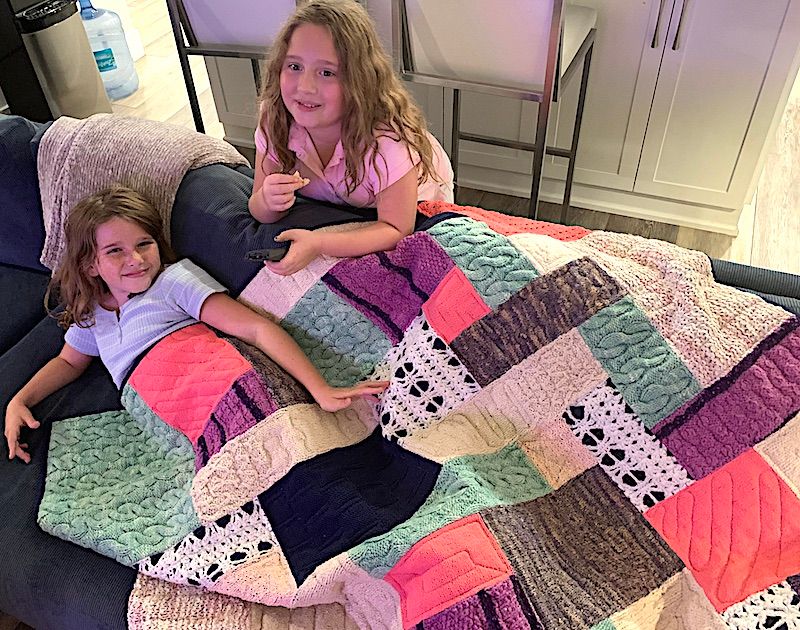
Section Summary
These and other considerations are indicators of the quality of a quilt. They also greatly influence the price of the quilt. For example, someone with great skill and artistry using cheap material might make a good looking quilt, but that quilt still has been made with cheap material, it will look cheap and not wear well. Conversely, a quilt made with high quality materials that is poorly made is still a poorly made quilt.
You want a quilt that is made from high quality materials by a skilled and artistic quilter. Read more about finding a quilt maker here.
Look carefully at the cost of memorial quilts. Be sure to know what you are paying for. A quilt that costs only $200 is probably going to be a disappointment.
↑Back to the Table of Contents
Conclusion
 I know grieving the loss of a loved one is never easy. Their clothing holds a unique power to bring both sorrow and solace. A memorial quilt made from your loved one's clothing can preserve the memories tied to those pieces.
I know grieving the loss of a loved one is never easy. Their clothing holds a unique power to bring both sorrow and solace. A memorial quilt made from your loved one's clothing can preserve the memories tied to those pieces.
Throughout this article, we’ve explored the many aspects of planning a memorial quilt—from deciding the timing, selecting recipients, to understanding the costs involved. Each step is part of the process of transforming your loved one’s clothing into something more than fabric—it becomes a tribute to their life and a reminder of the love you shared.
While the process can feel overwhelming, especially amid grief, taking the time to thoughtfully plan your quilt is worth it. A well-made memorial quilt isn’t just a heirloom; it’s a piece of your loved one’s story woven into your own. It’s okay if the journey brings tears—that’s part of healing. In time, your quilt will not only hold memories but also bring a sense of peace and warmth as you remember the one you’ve lost.
Take your time and know that this quilt will become a lasting reflection of love, memories, and comfort.

In 1992, Andrea Funk set out to reinvent the T-shirt quilt—and did. She pioneered the use of multi-size blocks and went on to develop six additional quilt styles, establishing Too Cool T-shirt Quilts as the creative engine behind the modern T-shirt quilt movement.

